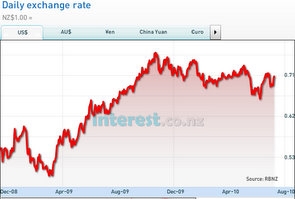
 By Mike Jones*
By Mike Jones*
The NZD consolidated its recent move higher overnight, and gained ground against most currencies due to a fall in risk-aversion.
NZD also received support on the back of a stronger AUD – a consequence of the better-than-expected Australian monthly jobs data released yesterday (yet another one).
This, of course, meant NZD lost ground against the even stronger AUD. Risk aversion fell in line with solid performances from bourses around the world with most equity markets up between 1 and 3%.
As expected, the BOE and the ECB left rates unchanged at their overnight meetings. This continues to highlight the contrasting economic environment in the region with economies in our part of the world, in which policy rates rates are under obvious upward pressure, in general.
After a spate of worse-than-expected data from the US, the markets took some cheer from initial jobless claims in the US being lower than anticipated. The drop in claims arrests, at least for now, the string of disappointing jobs data that have contributed to equity weakness over the past few weeks.
With the Dow looking set to close on a high note for the second day in a row the NZD looks likely to continue its march higher for now.
However, good US economic data is sporadic and equity markets are still susceptible to disappointments, so the NZD strength may well run its course in the mid-0.7100s as has been the case recently.
This week’s local data schedule comes to a close at 10:45 this morning, with publication of June’s electronic card transactions.
These have been all over the show over the last many months, with an almost-flat trend running through it. We expect June to post a moderate increase.
Only a very big increase, or a fall, would carry any significance.
Majors
A broadly positive Asian session and another strong data release from Australia in the shape of a blockbuster jobs report helped set the scene for a positive mood in Europe and the US. The significant change this week in RBA rate expectations – with the market moving from pricing a small cut ahead of this Tuesday’s RBA meeting to a 25% chance of a hike at the August meeting – have been a powerful prop for the AUD and risk generally, increasing the downward pressure on the USD.
Early European session weakness in GBP, with the market appearing to get sucked into a rise in GBP/USD to 1.5240 on unsubstantiated rumours of M&A-related trade before plunging back to 1.5125 amid reports of Asian sales and a soft HBoS house price report, momentarily threatened a pullback in other major pairs such as EUR/USD.
However the EUR held 1.2630 and on publication of well above forecast German May industrial production data managed to climb back to 1.2660. German industrial production rose 2.6% m/m against a forecast +0.9%, with an upward revision to April data too.
The numbers were boosted by a rise in metal and car production, challenging Thursday’s reading of softer factory orders data. However it may well be that last month’s strong foreign orders data are only now feeding through in to higher industrial production and that looking forward orders are easing off.
Germany’s export and import figures were also strong for May, bouncing back momentously from their April falls.
The ECB press conference saw President Trichet bat off questions on emergency loans, the sterilization of debt purchases and a barrage of questions on the stress tests. As usual Trichet gave little away but on the issue of rising Euribor rates – a feature of the withdrawal of longer-term emergency loans – Trichet stressed these were not a monetary policy signal and subtly implied the ECB may yet resort to extending loans should the situation warrant.
With the market gripped still by a weakening USD the possibility of more aggressive longer-term liquidity additions at the ECB is being ignored for now.
An IMF report suggesting the USD is overvalued and the Fed could indicate rates will stay lower for longer helped pressure the greenback, even if the USD comments are a long-term prognosis and mainly aimed at USD/Asia.
We are closing in on our targeted 1.27-1.28 area in EUR/USD. EUR/GBP remains a strategic sell at current levels with good resistance between 0.8400-25.
The BoE provided no surprises keeping rates, and its QE programme, unchanged. USD/JPY has recovered to 88.60 with risk, and on a succession of stops.
* Mike Jones is part of the BNZ research team. All its research is available here.
No chart with that title exists.
`

We welcome your comments below. If you are not already registered, please register to comment.
Remember we welcome robust, respectful and insightful debate. We don't welcome abusive or defamatory comments and will de-register those repeatedly making such comments. Our current comment policy is here.